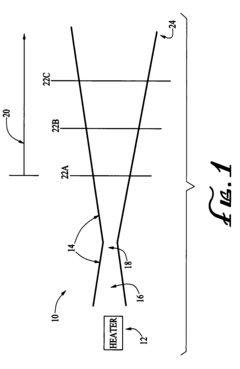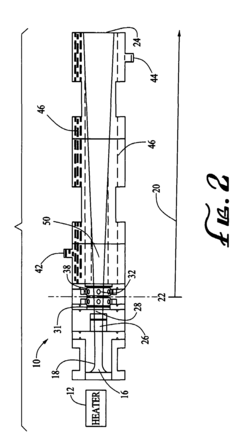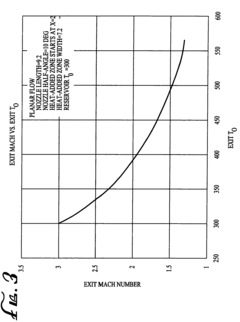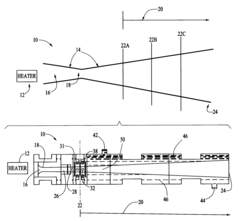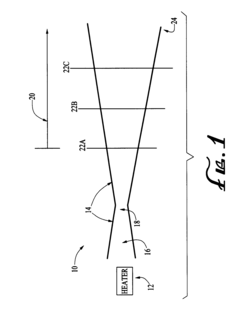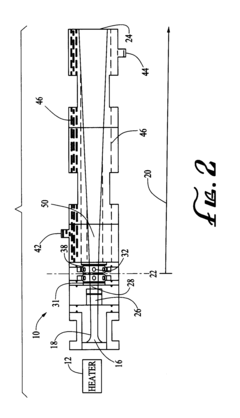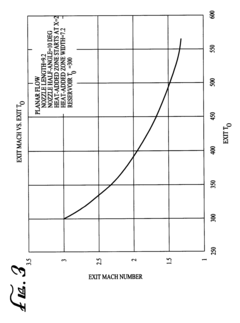Trace Chemistry Validation in Reducing Scramjet Engine Signatures
AUG 13, 20259 MIN READ
Generate Your Research Report Instantly with AI Agent
Patsnap Eureka helps you evaluate technical feasibility & market potential.
Scramjet Signature Reduction Background and Objectives
Scramjet engines have been a subject of intense research and development in the aerospace industry for decades. These engines offer the potential for high-speed, efficient propulsion in the hypersonic regime, making them attractive for both military and civilian applications. However, one of the significant challenges associated with scramjet technology is the reduction of engine signatures, which is crucial for maintaining stealth capabilities and minimizing environmental impact.
The evolution of scramjet technology can be traced back to the 1950s, with significant advancements occurring in the following decades. The primary goal of signature reduction in scramjet engines is to minimize detectable emissions, including thermal, acoustic, and chemical signatures. This objective aligns with broader efforts to enhance the overall performance and viability of hypersonic vehicles.
Trace chemistry validation plays a pivotal role in the pursuit of reducing scramjet engine signatures. This process involves the detailed analysis and verification of chemical species present in the engine exhaust, which contribute to its detectability. By understanding the composition and behavior of these trace elements, researchers can develop strategies to mitigate their presence or alter their characteristics to reduce the overall engine signature.
The technical objectives in this field are multifaceted. Firstly, there is a need to develop advanced diagnostic tools and methodologies for accurately detecting and quantifying trace chemical species in scramjet exhaust plumes. This includes the use of sophisticated spectroscopic techniques and high-fidelity computational models. Secondly, researchers aim to identify key chemical reactions and pathways that lead to the formation of signature-contributing species, with the goal of manipulating these processes to minimize detectability.
Another critical objective is the development of novel fuel formulations and injection strategies that can inherently reduce the formation of signature-enhancing compounds. This may involve the exploration of alternative fuels or additives that produce cleaner combustion products. Additionally, there is a focus on designing advanced nozzle geometries and exhaust management systems that can effectively dissipate or mask the engine's chemical signature.
The pursuit of these objectives is driven by both military and environmental considerations. For military applications, reducing scramjet signatures is essential for maintaining the stealth capabilities of hypersonic vehicles. In the civilian sector, minimizing engine signatures aligns with broader efforts to reduce the environmental impact of high-speed flight, particularly in terms of atmospheric emissions and potential effects on the ozone layer.
The evolution of scramjet technology can be traced back to the 1950s, with significant advancements occurring in the following decades. The primary goal of signature reduction in scramjet engines is to minimize detectable emissions, including thermal, acoustic, and chemical signatures. This objective aligns with broader efforts to enhance the overall performance and viability of hypersonic vehicles.
Trace chemistry validation plays a pivotal role in the pursuit of reducing scramjet engine signatures. This process involves the detailed analysis and verification of chemical species present in the engine exhaust, which contribute to its detectability. By understanding the composition and behavior of these trace elements, researchers can develop strategies to mitigate their presence or alter their characteristics to reduce the overall engine signature.
The technical objectives in this field are multifaceted. Firstly, there is a need to develop advanced diagnostic tools and methodologies for accurately detecting and quantifying trace chemical species in scramjet exhaust plumes. This includes the use of sophisticated spectroscopic techniques and high-fidelity computational models. Secondly, researchers aim to identify key chemical reactions and pathways that lead to the formation of signature-contributing species, with the goal of manipulating these processes to minimize detectability.
Another critical objective is the development of novel fuel formulations and injection strategies that can inherently reduce the formation of signature-enhancing compounds. This may involve the exploration of alternative fuels or additives that produce cleaner combustion products. Additionally, there is a focus on designing advanced nozzle geometries and exhaust management systems that can effectively dissipate or mask the engine's chemical signature.
The pursuit of these objectives is driven by both military and environmental considerations. For military applications, reducing scramjet signatures is essential for maintaining the stealth capabilities of hypersonic vehicles. In the civilian sector, minimizing engine signatures aligns with broader efforts to reduce the environmental impact of high-speed flight, particularly in terms of atmospheric emissions and potential effects on the ozone layer.
Market Analysis for Low-Signature Scramjet Engines
The market for low-signature scramjet engines is experiencing significant growth, driven by increasing demand for hypersonic vehicles in both military and civilian applications. The global hypersonic technology market, which includes scramjet engines, is projected to reach substantial value in the coming years, with a compound annual growth rate exceeding industry averages.
Military applications remain the primary driver for low-signature scramjet engines. Nations are investing heavily in hypersonic weapons and reconnaissance platforms, seeking to gain strategic advantages in speed and stealth. The United States, China, and Russia are at the forefront of this development, allocating substantial budgets to hypersonic research and development programs.
In the civilian sector, there is growing interest in hypersonic transport for both passenger and cargo applications. While still in early stages, companies are exploring the potential for intercontinental flights that could dramatically reduce travel times. This market segment, though smaller than military applications, shows promise for long-term growth.
The demand for low-signature scramjet engines is particularly strong in aerospace and defense industries. Major defense contractors and aerospace companies are actively developing and testing scramjet technologies, often in partnership with government agencies. These collaborations are crucial for advancing the technology and bringing it to operational readiness.
Market trends indicate a shift towards more efficient and environmentally friendly propulsion systems. Low-signature scramjet engines align with this trend, offering potential advantages in fuel efficiency and reduced emissions compared to traditional rocket engines. This aspect could drive adoption in both military and civilian applications as environmental regulations become more stringent.
Geographically, North America leads the market for low-signature scramjet engines, followed by Asia-Pacific and Europe. The concentration of aerospace and defense industries in these regions, coupled with significant government funding, contributes to their market dominance. Emerging economies in Asia and the Middle East are also showing increased interest, potentially opening new market opportunities.
The market faces challenges, including high development costs, technical complexities, and regulatory hurdles. However, the strategic importance of hypersonic technology is likely to sustain investment and drive continued market growth. As the technology matures and production scales up, costs are expected to decrease, potentially expanding the market to broader applications.
Military applications remain the primary driver for low-signature scramjet engines. Nations are investing heavily in hypersonic weapons and reconnaissance platforms, seeking to gain strategic advantages in speed and stealth. The United States, China, and Russia are at the forefront of this development, allocating substantial budgets to hypersonic research and development programs.
In the civilian sector, there is growing interest in hypersonic transport for both passenger and cargo applications. While still in early stages, companies are exploring the potential for intercontinental flights that could dramatically reduce travel times. This market segment, though smaller than military applications, shows promise for long-term growth.
The demand for low-signature scramjet engines is particularly strong in aerospace and defense industries. Major defense contractors and aerospace companies are actively developing and testing scramjet technologies, often in partnership with government agencies. These collaborations are crucial for advancing the technology and bringing it to operational readiness.
Market trends indicate a shift towards more efficient and environmentally friendly propulsion systems. Low-signature scramjet engines align with this trend, offering potential advantages in fuel efficiency and reduced emissions compared to traditional rocket engines. This aspect could drive adoption in both military and civilian applications as environmental regulations become more stringent.
Geographically, North America leads the market for low-signature scramjet engines, followed by Asia-Pacific and Europe. The concentration of aerospace and defense industries in these regions, coupled with significant government funding, contributes to their market dominance. Emerging economies in Asia and the Middle East are also showing increased interest, potentially opening new market opportunities.
The market faces challenges, including high development costs, technical complexities, and regulatory hurdles. However, the strategic importance of hypersonic technology is likely to sustain investment and drive continued market growth. As the technology matures and production scales up, costs are expected to decrease, potentially expanding the market to broader applications.
Current Challenges in Trace Chemistry Validation
Trace chemistry validation in reducing scramjet engine signatures faces several significant challenges in the current technological landscape. One of the primary obstacles is the extreme operating conditions within scramjet engines, which make it difficult to accurately measure and analyze trace chemical species. The high temperatures, pressures, and velocities of the supersonic combustion environment create a complex and dynamic system that is challenging to model and validate experimentally.
Another major hurdle is the limited availability of high-fidelity diagnostic tools capable of operating in such harsh conditions. Traditional spectroscopic techniques often struggle to provide reliable data due to interference from the intense background radiation and the rapid timescales of chemical reactions occurring within the engine. This limitation hampers the ability to precisely identify and quantify trace species that may contribute to engine signatures.
The transient nature of scramjet combustion processes further complicates trace chemistry validation efforts. The short residence times of reactants and products within the engine make it challenging to capture and analyze the fleeting chemical intermediates that may play crucial roles in signature formation. This temporal constraint necessitates the development of ultra-fast measurement techniques and data acquisition systems, which are still in their infancy for scramjet applications.
Additionally, the multiscale nature of the problem poses a significant challenge. Trace chemistry interactions occur at the molecular level, while engine signatures manifest at macroscopic scales. Bridging this gap requires sophisticated multi-physics modeling approaches that can accurately capture the interplay between chemical kinetics, fluid dynamics, and heat transfer across various spatial and temporal scales.
The scarcity of experimental data from actual scramjet flight tests presents another obstacle. Most validation efforts rely heavily on ground-based facilities, which may not fully replicate the conditions encountered during hypersonic flight. This discrepancy introduces uncertainties in the extrapolation of ground test results to real-world scenarios, potentially leading to inaccurate predictions of engine signatures.
Furthermore, the complexity of chemical reaction mechanisms involved in scramjet combustion adds another layer of difficulty to trace chemistry validation. The high-energy environment can lead to the formation of numerous intermediate species and radical compounds, many of which are not well understood or characterized. Developing comprehensive reaction mechanisms that accurately account for these trace species and their interactions remains a formidable challenge.
Lastly, the interdisciplinary nature of the problem requires collaboration between experts in various fields, including combustion chemistry, fluid dynamics, materials science, and sensor technology. Coordinating these diverse areas of expertise and integrating their insights into a cohesive validation framework presents both organizational and technical challenges that must be overcome to advance the state of the art in trace chemistry validation for scramjet engine signature reduction.
Another major hurdle is the limited availability of high-fidelity diagnostic tools capable of operating in such harsh conditions. Traditional spectroscopic techniques often struggle to provide reliable data due to interference from the intense background radiation and the rapid timescales of chemical reactions occurring within the engine. This limitation hampers the ability to precisely identify and quantify trace species that may contribute to engine signatures.
The transient nature of scramjet combustion processes further complicates trace chemistry validation efforts. The short residence times of reactants and products within the engine make it challenging to capture and analyze the fleeting chemical intermediates that may play crucial roles in signature formation. This temporal constraint necessitates the development of ultra-fast measurement techniques and data acquisition systems, which are still in their infancy for scramjet applications.
Additionally, the multiscale nature of the problem poses a significant challenge. Trace chemistry interactions occur at the molecular level, while engine signatures manifest at macroscopic scales. Bridging this gap requires sophisticated multi-physics modeling approaches that can accurately capture the interplay between chemical kinetics, fluid dynamics, and heat transfer across various spatial and temporal scales.
The scarcity of experimental data from actual scramjet flight tests presents another obstacle. Most validation efforts rely heavily on ground-based facilities, which may not fully replicate the conditions encountered during hypersonic flight. This discrepancy introduces uncertainties in the extrapolation of ground test results to real-world scenarios, potentially leading to inaccurate predictions of engine signatures.
Furthermore, the complexity of chemical reaction mechanisms involved in scramjet combustion adds another layer of difficulty to trace chemistry validation. The high-energy environment can lead to the formation of numerous intermediate species and radical compounds, many of which are not well understood or characterized. Developing comprehensive reaction mechanisms that accurately account for these trace species and their interactions remains a formidable challenge.
Lastly, the interdisciplinary nature of the problem requires collaboration between experts in various fields, including combustion chemistry, fluid dynamics, materials science, and sensor technology. Coordinating these diverse areas of expertise and integrating their insights into a cohesive validation framework presents both organizational and technical challenges that must be overcome to advance the state of the art in trace chemistry validation for scramjet engine signature reduction.
Existing Trace Chemistry Validation Methods
01 Scramjet engine design and performance optimization
This category focuses on improving the design and performance of scramjet engines. It includes innovations in engine geometry, fuel injection systems, and combustion chamber designs to enhance efficiency, thrust, and overall performance. These advancements aim to optimize the engine's operation across various flight conditions and reduce its signature.- Scramjet engine design and performance optimization: This category focuses on improving the design and performance of scramjet engines. It includes innovations in engine geometry, fuel injection systems, and combustion chamber designs to enhance efficiency, thrust, and overall performance. These advancements aim to optimize the engine's operation across various flight conditions and reduce its signature.
- Thermal management and cooling systems: This area addresses the challenges of managing extreme temperatures in scramjet engines. It involves developing advanced cooling techniques, heat-resistant materials, and thermal protection systems. These innovations help maintain engine integrity, reduce thermal signatures, and improve overall engine performance and longevity.
- Exhaust plume signature reduction: This category focuses on techniques to minimize the exhaust plume signature of scramjet engines. It includes methods for reducing infrared and radar signatures through exhaust gas cooling, plume shaping, and the use of advanced materials. These technologies aim to enhance the stealth capabilities of scramjet-powered vehicles.
- Fuel composition and injection strategies: This area explores innovative fuel compositions and injection strategies for scramjet engines. It includes research on alternative fuels, fuel additives, and advanced injection systems to improve combustion efficiency, reduce emissions, and minimize engine signatures. These advancements aim to enhance engine performance while reducing its environmental impact.
- Sensor systems and signature detection: This category focuses on developing advanced sensor systems for detecting and analyzing scramjet engine signatures. It includes innovations in infrared, acoustic, and electromagnetic sensors, as well as signal processing techniques. These technologies aim to improve the detection and identification of scramjet-powered vehicles for both defensive and offensive purposes.
02 Thermal management and cooling systems
This area addresses the challenges of managing extreme temperatures in scramjet engines. It involves developing advanced cooling techniques, heat-resistant materials, and thermal protection systems. These innovations help maintain engine integrity, reduce thermal signatures, and improve overall engine performance and longevity.Expand Specific Solutions03 Exhaust plume signature reduction
This category focuses on techniques to minimize the exhaust plume signature of scramjet engines. It includes methods for reducing infrared and radar signatures through advanced nozzle designs, exhaust gas cooling, and the use of signature-suppressing additives. These innovations aim to enhance the stealth capabilities of scramjet-powered vehicles.Expand Specific Solutions04 Fuel composition and injection strategies
This area explores innovative fuel compositions and injection strategies for scramjet engines. It includes the development of high-energy fuels, advanced fuel injection systems, and mixing techniques to improve combustion efficiency and reduce engine signatures. These advancements aim to optimize engine performance while minimizing detectable emissions.Expand Specific Solutions05 Sensor systems and signature analysis
This category focuses on developing advanced sensor systems and analytical tools for detecting and characterizing scramjet engine signatures. It includes innovations in infrared, acoustic, and electromagnetic sensors, as well as signal processing algorithms for signature analysis. These technologies are crucial for both engine performance monitoring and potential countermeasure development.Expand Specific Solutions
Key Players in Scramjet Engine Development
The competitive landscape for "Trace Chemistry Validation in Reducing Scramjet Engine Signatures" is in its early development stage, with limited market size due to the specialized nature of scramjet technology. The field is characterized by high technical complexity and is primarily driven by defense and aerospace sectors. Key players like National University of Defense Technology, University of Maryland, and Beihang University are at the forefront of research, while companies such as GLOBALFOUNDRIES and Siemens AG may contribute advanced manufacturing and sensing technologies. The technology's maturity is still evolving, with ongoing research focused on improving engine efficiency and reducing detectable signatures for military applications.
National University of Defense Technology
Technical Solution: The National University of Defense Technology has developed advanced computational fluid dynamics (CFD) models to simulate and analyze trace chemistry in scramjet engine exhausts. Their approach combines high-fidelity numerical simulations with experimental validation to accurately predict chemical species concentrations and thermal signatures. The university has implemented adaptive mesh refinement techniques to resolve fine-scale turbulent mixing and chemical reactions in the engine plume[1]. They have also integrated detailed chemical kinetics mechanisms to capture the complex interactions between fuel combustion products and atmospheric species at hypersonic velocities[2]. This enables precise modeling of infrared and ultraviolet emissions from the exhaust for signature reduction studies.
Strengths: Cutting-edge CFD capabilities, integration of detailed chemistry models. Weaknesses: High computational costs, limited real-world engine testing data for validation.
Beijing Power Machinery Institute
Technical Solution: Beijing Power Machinery Institute has developed innovative fuel injection and mixing strategies to reduce trace species concentrations in scramjet exhausts. Their approach focuses on optimizing fuel-air mixing to achieve more complete combustion and minimize unburned hydrocarbons and intermediate species. The institute has designed and tested novel injector geometries that enhance turbulent mixing while maintaining flame stability at hypersonic speeds[3]. They have also explored the use of catalytic combustion chambers to promote low-temperature oxidation of fuel, reducing the formation of NOx and other pollutants[4]. Additionally, the institute has investigated plasma-assisted combustion techniques to enhance ignition and flame-holding in supersonic flows, potentially enabling leaner fuel mixtures and cleaner exhaust signatures.
Strengths: Practical focus on engine hardware design, extensive ground testing capabilities. Weaknesses: Limited experience with full-scale flight testing, potential challenges in scaling up technologies.
Innovative Approaches in Signature Reduction Chemistry
Method for using variable supersonic Mach number air heater utilizing supersonic combustion
PatentInactiveUS7296396B1
Innovation
- A supersonic combustion heater apparatus that varies exit plane Mach numbers through strategic fuel injection and flame stabilization in a fixed geometry nozzle, enhancing high enthalpy flow and flame stability without using expensive film cooled nozzles, allowing for mode transition testing in air-breathing propulsion systems.
Variable supersonic mach number air heater utilizing supersonic combustion
PatentInactiveUS8087229B2
Innovation
- A supersonic combustion heater with strategically positioned fuel injection means and flame stabilization techniques that vary Mach numbers at the exit plane by heat addition in the diverging area, enhancing enthalpy flow, flame stability, and mixing without the need for expensive film-cooled nozzles, using a fixed geometric nozzle with converging and diverging areas and incorporating oxygen injection for stability.
Environmental Impact of Scramjet Engine Emissions
The environmental impact of scramjet engine emissions is a critical consideration in the development and deployment of hypersonic propulsion systems. Scramjet engines, designed to operate at supersonic speeds, produce a unique set of emissions that can have significant effects on the atmosphere and surrounding ecosystems. These emissions primarily consist of nitrogen oxides (NOx), water vapor, and carbon dioxide, along with trace amounts of other combustion byproducts.
Nitrogen oxides, formed during the high-temperature combustion process, are of particular concern due to their role in ozone depletion and the formation of acid rain. At high altitudes, where scramjet engines typically operate, NOx emissions can have a more pronounced effect on the ozone layer compared to emissions from conventional aircraft. This potential for stratospheric ozone depletion raises concerns about increased ultraviolet radiation reaching the Earth's surface.
Water vapor emissions from scramjet engines, while seemingly benign, can contribute to the formation of contrails and cirrus clouds at high altitudes. These artificial cloud formations can alter the Earth's radiation balance, potentially contributing to localized warming or cooling effects. The extent of this impact depends on factors such as flight frequency, atmospheric conditions, and the specific operational altitude of the scramjet-powered vehicles.
Carbon dioxide emissions, although present in smaller quantities compared to traditional jet engines due to the scramjet's higher efficiency, still contribute to the overall greenhouse gas inventory. The cumulative effect of these emissions, especially if scramjet technology becomes widely adopted, could have long-term implications for global climate change.
The unique operational characteristics of scramjet engines, including their high-altitude flight profiles and supersonic speeds, introduce additional environmental considerations. The potential for sonic booms and their impact on terrestrial ecosystems and human populations must be carefully evaluated. Furthermore, the release of particulate matter and other trace elements at high altitudes may have unforeseen consequences on atmospheric chemistry and cloud formation processes.
As research in scramjet technology progresses, there is an increasing focus on developing cleaner combustion processes and more environmentally friendly fuels. Efforts are being made to optimize engine designs to reduce NOx formation and minimize overall emissions. Additionally, the exploration of alternative fuels, such as hydrogen, offers the potential for significantly reduced carbon emissions, although challenges related to production and storage remain.
Nitrogen oxides, formed during the high-temperature combustion process, are of particular concern due to their role in ozone depletion and the formation of acid rain. At high altitudes, where scramjet engines typically operate, NOx emissions can have a more pronounced effect on the ozone layer compared to emissions from conventional aircraft. This potential for stratospheric ozone depletion raises concerns about increased ultraviolet radiation reaching the Earth's surface.
Water vapor emissions from scramjet engines, while seemingly benign, can contribute to the formation of contrails and cirrus clouds at high altitudes. These artificial cloud formations can alter the Earth's radiation balance, potentially contributing to localized warming or cooling effects. The extent of this impact depends on factors such as flight frequency, atmospheric conditions, and the specific operational altitude of the scramjet-powered vehicles.
Carbon dioxide emissions, although present in smaller quantities compared to traditional jet engines due to the scramjet's higher efficiency, still contribute to the overall greenhouse gas inventory. The cumulative effect of these emissions, especially if scramjet technology becomes widely adopted, could have long-term implications for global climate change.
The unique operational characteristics of scramjet engines, including their high-altitude flight profiles and supersonic speeds, introduce additional environmental considerations. The potential for sonic booms and their impact on terrestrial ecosystems and human populations must be carefully evaluated. Furthermore, the release of particulate matter and other trace elements at high altitudes may have unforeseen consequences on atmospheric chemistry and cloud formation processes.
As research in scramjet technology progresses, there is an increasing focus on developing cleaner combustion processes and more environmentally friendly fuels. Efforts are being made to optimize engine designs to reduce NOx formation and minimize overall emissions. Additionally, the exploration of alternative fuels, such as hydrogen, offers the potential for significantly reduced carbon emissions, although challenges related to production and storage remain.
Regulatory Framework for Hypersonic Propulsion Systems
The regulatory framework for hypersonic propulsion systems, including scramjet engines, is a complex and evolving landscape. As these technologies advance rapidly, governments and international bodies are working to establish comprehensive guidelines to ensure safety, environmental protection, and responsible development.
At the national level, countries with active hypersonic research programs, such as the United States, Russia, and China, have begun to implement regulations specific to hypersonic propulsion. In the U.S., the Federal Aviation Administration (FAA) and the Department of Defense (DoD) are collaborating to develop certification standards for hypersonic vehicles and their propulsion systems. These efforts focus on addressing the unique challenges posed by extreme temperatures, pressures, and velocities associated with hypersonic flight.
Internationally, organizations like the International Civil Aviation Organization (ICAO) are exploring the need for global standards governing hypersonic propulsion systems. Key areas of focus include airspace management, emissions control, and noise regulations. The ICAO's Committee on Aviation Environmental Protection (CAEP) is particularly interested in understanding and mitigating the potential environmental impacts of scramjet engines and other hypersonic propulsion technologies.
Environmental concerns play a significant role in shaping the regulatory landscape. Trace chemistry validation in reducing scramjet engine signatures is becoming increasingly important as regulators seek to minimize the environmental footprint of these advanced propulsion systems. Emissions standards for hypersonic engines are still in development, with particular attention being paid to high-altitude emissions and their potential effects on the ozone layer.
Safety regulations are another critical aspect of the framework. Given the extreme operating conditions of scramjet engines, regulatory bodies are working to establish stringent safety protocols for testing, operation, and maintenance. This includes developing new standards for materials, fuel systems, and control mechanisms capable of withstanding the harsh hypersonic environment.
As the technology matures, it is expected that the regulatory framework will continue to evolve. International cooperation and harmonization of standards will be crucial to ensure consistent global regulations for hypersonic propulsion systems. This will likely involve collaborative efforts between aerospace agencies, environmental organizations, and defense departments worldwide.
At the national level, countries with active hypersonic research programs, such as the United States, Russia, and China, have begun to implement regulations specific to hypersonic propulsion. In the U.S., the Federal Aviation Administration (FAA) and the Department of Defense (DoD) are collaborating to develop certification standards for hypersonic vehicles and their propulsion systems. These efforts focus on addressing the unique challenges posed by extreme temperatures, pressures, and velocities associated with hypersonic flight.
Internationally, organizations like the International Civil Aviation Organization (ICAO) are exploring the need for global standards governing hypersonic propulsion systems. Key areas of focus include airspace management, emissions control, and noise regulations. The ICAO's Committee on Aviation Environmental Protection (CAEP) is particularly interested in understanding and mitigating the potential environmental impacts of scramjet engines and other hypersonic propulsion technologies.
Environmental concerns play a significant role in shaping the regulatory landscape. Trace chemistry validation in reducing scramjet engine signatures is becoming increasingly important as regulators seek to minimize the environmental footprint of these advanced propulsion systems. Emissions standards for hypersonic engines are still in development, with particular attention being paid to high-altitude emissions and their potential effects on the ozone layer.
Safety regulations are another critical aspect of the framework. Given the extreme operating conditions of scramjet engines, regulatory bodies are working to establish stringent safety protocols for testing, operation, and maintenance. This includes developing new standards for materials, fuel systems, and control mechanisms capable of withstanding the harsh hypersonic environment.
As the technology matures, it is expected that the regulatory framework will continue to evolve. International cooperation and harmonization of standards will be crucial to ensure consistent global regulations for hypersonic propulsion systems. This will likely involve collaborative efforts between aerospace agencies, environmental organizations, and defense departments worldwide.
Unlock deeper insights with Patsnap Eureka Quick Research — get a full tech report to explore trends and direct your research. Try now!
Generate Your Research Report Instantly with AI Agent
Supercharge your innovation with Patsnap Eureka AI Agent Platform!

